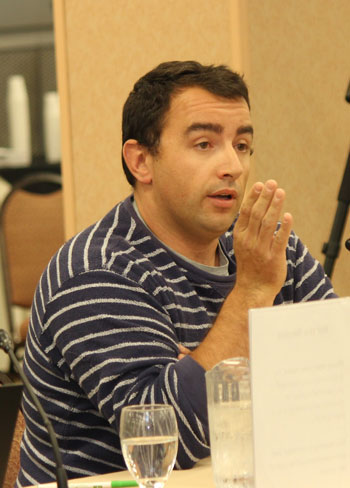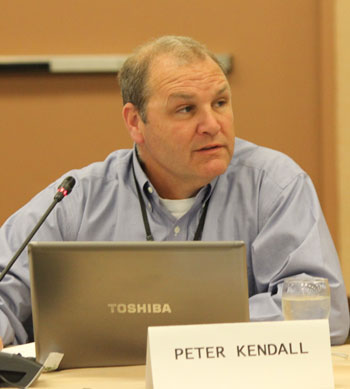“Disaster” – 86% Reduction in Atlantic Herring
continued from January 2019 Homepage

Chris Weiner, a CHOIR member and tuna fisherman. “An 86 percent reduction in revenue is a disaster.” Fishermen’s Voice photo.
NEFMC’s vote was a rejection of a proposed rule by the National Marine Fisheries Service (NMFS) that would implement a higher ABC of 30,688 metric tons. The NMFS proposal projects a revenue reduction of 80 percent.
The ABC for 2018 was 111,000 metric tons.
In its proposed rule, NMFS said its proposed ABC would result in an annual catch limit (ACL) of 24,488 metric tons, which is almost 10,000 metric tons higher than the ACL that would result from the NEFMC proposal.
Allowing the additional harvest would conserve herring biomass while mitigating severe economic hardship on the herring industry, NMFS’s proposal says.
“Because the majority of herring catch is bait for the lobster fishery, we expect this additional harvest to help minimize the negative economic impacts associated with bait shortages and higher bait prices on the lobster fishery,” the proposal says.
NEFMC member and Maine Department of Marine Resources (DMR) Commissioner Patrick Keliher said he struggled with the issue and the short-term and medium-term impacts of both proposals, particularly with regard to the economic impacts to both Maine’s herring and lobster industries.
“The economic impact, both to the herring fleet and the lobster industry, is very, very real,” said Keliher. “I’m trying to figure out if there’s some relief here and trying to balance these two things. But we’re in a pretty difficult spot.”
Peter Kendall, chairman of NEFMC’s Herring Committee, said he didn’t support the NMFS proposal.
“I stand by what the council voted on in September,” Kendall said.

Peter Kendall, NEFMC “I stand by what the council voted on in September. NMFS’s proposed ABC is set at the same level as the overfishing limit (OFL) of 30,688 metric tons, which implies that there’s no uncertainty in the fishery. As we’ve seen in almost all fisheries, and especially this fishery, it’s unlikely that there‘s no uncertainty in the model.” Fishermen’s Voice photo.
NMFS’s proposed ABC is set at the same level as the overfishing limit (OFL) of 30,688 metric tons, “which implies that there’s no uncertainty in the fishery,” Kendall continued. “As we’ve seen in almost all fisheries, and especially this fishery, it’s unlikely that there‘s no uncertainty in the model.”
The NMFS proposal, he said, could result in an ABC for fishing year 2020 that’s even lower than the NEFMC proposal, he said. “You’re likely going to pay for that in 2020,” he said. “I don’t think it’s worth taking that risk.”
The NEFMC proposal recommends an ABC of 16,131 metric tons for each of fishing years 2020 and 2021. The NEFMC proposal sets the OFL for 2019 at 30,668 metric tons, for 2020 at 38,878 metric tons, and for 2021 at 59,788 metric tons.
Kendall said he understands that the industry would like a higher ABC for 2019, “but I’d like to stick with what the council took a long time to go through, that painstaking effort to try and rebuild the herring stock.”
NEFMC member Matthew McKenzie said he agreed with Kendall.
“Given the level of uncertainty we have and the heavily declined state of the stock, we need to be more cautious than that in this period of transition,” he said.
NEFMC vice chairman Terry Stockwell said he also agreed with Kendall.
“We’re trying to provide stability for the industry, but that’s not the proper way to do business,” he said of the NMFS proposal.
If we get stuck with
12,000 or 15,000 metric
tons after this, that’s
beyond devastating.
– Vince Balzano,
NEFMC member
NEFMC member Vincent Balzano said he understands NMFS’s reasoning, given the
“horrifying” impacts of the quota cuts on the fishery. But, he said, “If we take all this fish up front, there’s no guarantee we’ll get to the fish in the back. That’s my biggest concern. I agree it’s devastating to the herring and Maine lobster fisheries. But if we get stuck with 12,000 or 15,000 metric tons after this, that’s beyond devastating.”
“What we do in 2019 has an effect on whether we get the bounceback that we’d like to see begin in 2021,” said NEFMC member Michael Sissenwine.
How are we not talking
about a disaster here?
– Chris Weiner,
CHOIR member
Erica Fuller, a senior attorney with the Conservation Law Foundation, said NMFS’s proposed rule sets “a dangerous precedent.” After years of discussing the role of herring as forage, she said, NEFMC “made the tough decision” to recommend a tougher ABC. “Setting the ABC at OFL is only appropriate when there’s no scientific uncertainty, and there’s a significant amount of scientific uncertainty,” she said.
Jeff Kaelin, of Lund’s Fisheries in Cape May, N.J., said, for the lobster industry, frozen bait will likely become more prevalent.
“As the lobster industry tries to get through this situation, that’s just going to be the nature of the beast,” he said. The development of more freezing capacity has taken place in Maine and other places, and the cost of bait will likely go up, he said.
“The economic impact,
both to the herring
fleet and the lobster
industry, is very,
very real.”
– Pat Keliher, commissioner,
Maine DMR
In opposing the motion for NEFMC to reiterate its support of its original 2019 ABC recommendation, Keliher said, “The economics of this are devastating to the fleet,” adding, “It’s a roll of the dice how much risk we’re going to take and I think the agency [NMFS] has done a good job balancing that risk with their proposed rule.”
According to NEFMC information, although the latest assessment of herring showed that the stock was not overfished and overfishing was not occurring in 2017, recent low recruitment is projected to result in a biomass decline. The assessment projected that catch needs to be reduced to prevent overfishing and to lower the risk of the stock becoming overfished. For fishing year 2018, that resulted in NMFS and NEFMC using an in-season adjustment to reduce the 2018 herring annual catch limit to 49,900 metric tons, down from the originally scheduled 104,800 metric tons, to prevent overfishing.
